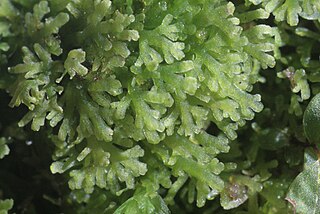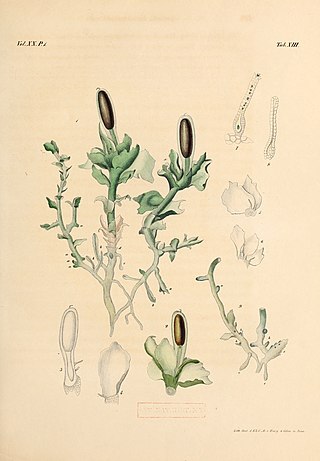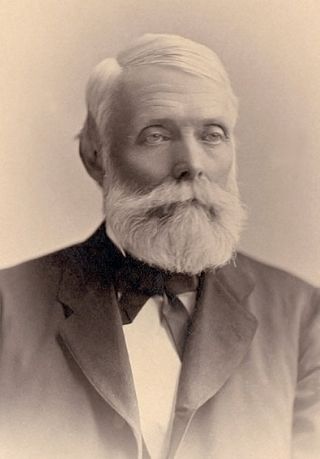Related Research Articles

Mosses are small, non-vascular flowerless plants in the taxonomic division Bryophytasensu stricto. Bryophyta may also refer to the parent group bryophytes, which comprise liverworts, mosses, and hornworts. Mosses typically form dense green clumps or mats, often in damp or shady locations. The individual plants are usually composed of simple leaves that are generally only one cell thick, attached to a stem that may be branched or unbranched and has only a limited role in conducting water and nutrients. Although some species have conducting tissues, these are generally poorly developed and structurally different from similar tissue found in vascular plants. Mosses do not have seeds and after fertilisation develop sporophytes with unbranched stalks topped with single capsules containing spores. They are typically 0.2–10 cm (0.1–3.9 in) tall, though some species are much larger. Dawsonia, the tallest moss in the world, can grow to 50 cm (20 in) in height. There are approximately 12,000 species.
IAB may refer to:

Bryophytes are a group of land plants, sometimes treated as a taxonomic division, that contains three groups of non-vascular land plants (embryophytes): the liverworts, hornworts and mosses. In the strict sense, Bryophyta consists of the mosses only. Bryophytes are characteristically limited in size and prefer moist habitats although they can survive in drier environments. The bryophytes consist of about 20,000 plant species. Bryophytes produce enclosed reproductive structures, but they do not produce flowers or seeds. They reproduce sexually by spores and asexually by fragmentation or the production of gemmae. Though bryophytes were considered a paraphyletic group in recent years, almost all of the most recent phylogenetic evidence supports the monophyly of this group, as originally classified by Wilhelm Schimper in 1879. The term bryophyte comes from Ancient Greek βρύον (brúon) 'tree moss, liverwort', and φυτόν (phutón) 'plant'.

The Marchantiophyta are a division of non-vascular land plants commonly referred to as hepatics or liverworts. Like mosses and hornworts, they have a gametophyte-dominant life cycle, in which cells of the plant carry only a single set of genetic information.

Hornworts are a group of non-vascular Embryophytes constituting the division Anthocerotophyta. The common name refers to the elongated horn-like structure, which is the sporophyte. As in mosses and liverworts, hornworts have a gametophyte-dominant life cycle, in which cells of the plant carry only a single set of genetic information; the flattened, green plant body of a hornwort is the gametophyte stage of the plant.

Metzgeriales is an order of liverworts. The group is sometimes called the simple thalloid liverworts: "thalloid" because the members lack structures resembling stems or leaves, and "simple" because their tissues are thin and relatively undifferentiated. All species in the order have a small gametophyte stage and a smaller, relatively short-lived, spore-bearing stage. Although these plants are almost entirely restricted to regions with high humidity or readily available moisture, the group as a whole is widely distributed, and occurs on every continent except Antarctica.
Monoicy is a sexual system in haploid plants where both sperm and eggs are produced on the same gametophyte, in contrast with dioicy, where each gametophyte produces only sperm or eggs but never both. Both monoicous and dioicous gametophytes produce gametes in gametangia by mitosis rather than meiosis, so that sperm and eggs are genetically identical with their parent gametophyte.

Bryology is the branch of botany concerned with the scientific study of bryophytes. Bryologists are people who have an active interest in observing, recording, classifying or researching bryophytes. The field is often studied along with lichenology due to the similar appearance and ecological niche of the two organisms, even though bryophytes and lichens are not classified in the same kingdom.

Haplomitriopsida is a newly recognized class of liverworts comprising fifteen species in three genera. Recent cladistic analyses of nuclear, mitochondrial, and plastid gene sequences place this monophyletic group as the basal sister group to all other liverworts. The group thus provides a unique insight into the early evolution of liverworts in particular and of land plants in general.
Ilma Grace Stone, née Balfe, was an Australian botanist who specialised in bryology. She was an author, collector, and researcher of Australian mosses, a subject on which she lectured and wrote.

The American Bryological and Lichenological Society is an organization devoted to the scientific study of all aspects of the biology of bryophytes and lichen-forming fungi and is one of the nation's oldest botanical organizations. It was originally known as the Sullivant Moss Society, named after William Starling Sullivant. The Society publishes a quarterly journal distributed worldwide, The Bryologist, which includes articles on all aspects of the biology of mosses, hornworts, liverworts and lichens. The Society also publishes the quarterly journal Evansia, which is intended for both amateurs and professionals in bryology and lichenology and is focused on North America.
The British Bryological Society is an academic society dedicated to bryology, which encourages the study of bryophytes. It publishes the peer-reviewed Journal of Bryology.

Thomas Potts James (1803–1882) was an American botanist and bryologist. He made important contributions to the study of bryophytes. He wrote the section on mosses and liverworts in William Darlington's Flora Cestrica (1853).

William Campbell Steere (1907–1989) was an American botanist known as an expert on bryophytes, especially arctic and tropical American species. The standard author abbreviation Steere is used to indicate this person as the author when citing a botanical name.
Petalophyllum, or petalwort, is a genus of liverworts in the order Fossombroniales.
Jan-Peter Frahm was a German botanist dedicated to the study of mosses. The standard author abbreviation J.-P.Frahm is used to indicate this person as the author when citing a botanical name.
Geneva Sayre was an American bryologist and bibliographer. She "pioneered bibliographical and historical bryology, a new field in the study, evaluation, and organization of the literature of bryology."
Wilfred "Wilf" Borden Schofield was a Canadian botanist, specializing in mosses and liverworts. He was considered by many "the foremost bryologist in Canada".
Martha Elizabeth Newton was a British bryologist and botanist, specialising in cytology and field surveying.
Jean Annette Paton is a British botanist, bryologist and botanical illustrator. She has written many books on the bryology of the United Kingdom and the flora of Cornwall, and described several new species.
References
- ↑ "International Association of Bryologists". International Association of Bryologists. 2011. Retrieved December 6, 2011.
- ↑ "International Association of Bryologists". Taxon. 21 (2/3): 375–376. 1972. doi:10.1002/j.1996-8175.1972.tb03282.x. JSTOR 1218235.
- ↑ N. G. Hodgetts (2000). Mosses, liverworts, and hornworts: status survey and conservation action plan for bryophytes. IUCN. p. 2. ISBN 9782831704661.
- ↑ Benito C. Tan & Tamás Pócs (2000). "Bryogeography and conservation of bryophytes". In Arthur Jonathan Shaw & Bernard Goffinet (ed.). Bryophyte Biology. Cambridge University Press. pp. 403–448. ISBN 9780521667944.